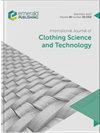用有限元法预测胸垫规格对跳跃过程中乳房变形的影响
IF 1
4区 工程技术
Q3 MATERIALS SCIENCE, TEXTILES
International Journal of Clothing Science and Technology
Pub Date : 2023-08-08
DOI:10.1108/ijcst-02-2023-0009
引用次数: 0
摘要
目的采用有限元法预测胸垫规格对跳跃过程中乳房变形的影响。乳房变形是女性在运动过程中关注的一个关键问题,运动文胸可以有效地控制乳房变形。在大多数研究中,使用动作捕捉设备来测量穿着运动胸罩时乳房的变形,以判断其有效性。然而,这种设备的操作非常复杂且耗时。计算机辅助技术是模拟这些实验的有效手段。设计/方法/方法在本研究中,乳房模型采用三维(3D)扫描获得。利用逆向工程和计算机辅助设计(CAD)软件,获得装配模型进行有限元分析。在有限元仿真软件中完成前处理、求解和后处理,得到乳房变形结果。为了扩展这些模型的应用范围,我们在胸罩内部构建了不同尺寸和厚度的衬垫来模拟衬垫对乳房变形的影响。结果:各模型的计算均方根误差均<1%,表明有限元与实验数据吻合较好。乳头变形在大多数模型中都是最大的。在所有模型中,乳房上部变形最小。此外,较大的护垫对减少乳房变形没有效果;然而,更厚的垫子是。该方法提供了一种有效的方法来预测乳房在多个位置的变形,为设计紧凑型文胸提供了方便。本文章由计算机程序翻译,如有差异,请以英文原文为准。
Predicting the effect of bra pad specifications on breast deformation during jumping using a finite element method
PurposeThe purpose of this paper is to predict the effect of bra pad specifications on breast deformation during jumping using a finite element (FE) method. Breast deformation is a key concern for women during exercise and can be effectively controlled with sports bras. In most studies, the deformation of breasts when wearing a sports bra is measured using motion capture devices to judge their effectiveness. However, the operation of such devices is highly complex and time-consuming. Computer-aided technology is an efficient way to simulate these experiments.Design/methodology/approachIn this study, the breast model was obtained using three-dimensional (3D) scanning. Assembling models were obtained for FE analysis using reverse engineering and computer-aided design (CAD) software. The breast deformation results were obtained by completing pre-processing, solving and post-processing in the FE simulation software. To extend the application of these models, pads of different sizes and thicknesses within the bra were constructed to simulate the effect of pads on breast deformation.FindingsThe calculated root mean square errors were <1%, which indicated good agreement between the FE and experimental data in all the models. Nipple deformation was always the largest in most models. The smallest deformation occurred at the superior position of breasts in all models. In addition, larger pads were not effective in reducing breast deformation; however, thicker pads were.Originality/valueThe method developed in this study provides an effective way to predict breast deformation in multiple positions and is convenient for designing compression bras.
求助全文
通过发布文献求助,成功后即可免费获取论文全文。
去求助
来源期刊
CiteScore
2.40
自引率
8.30%
发文量
51
审稿时长
10 months
期刊介绍:
Addresses all aspects of the science and technology of clothing-objective measurement techniques, control of fibre and fabric, CAD systems, product testing, sewing, weaving and knitting, inspection systems, drape and finishing, etc. Academic and industrial research findings are published after a stringent review has taken place.

 求助内容:
求助内容: 应助结果提醒方式:
应助结果提醒方式:


